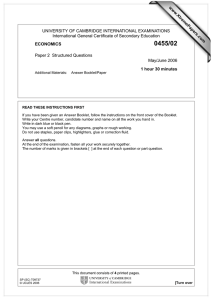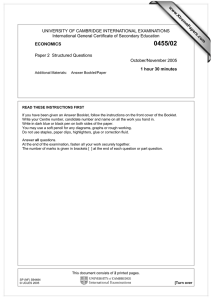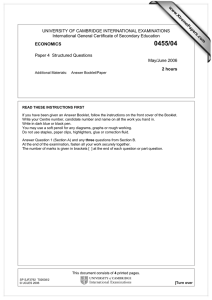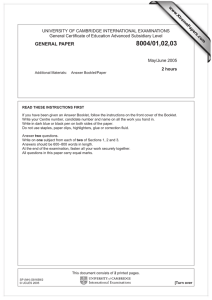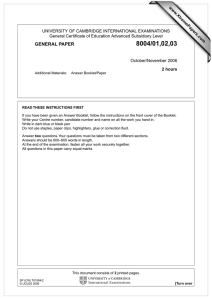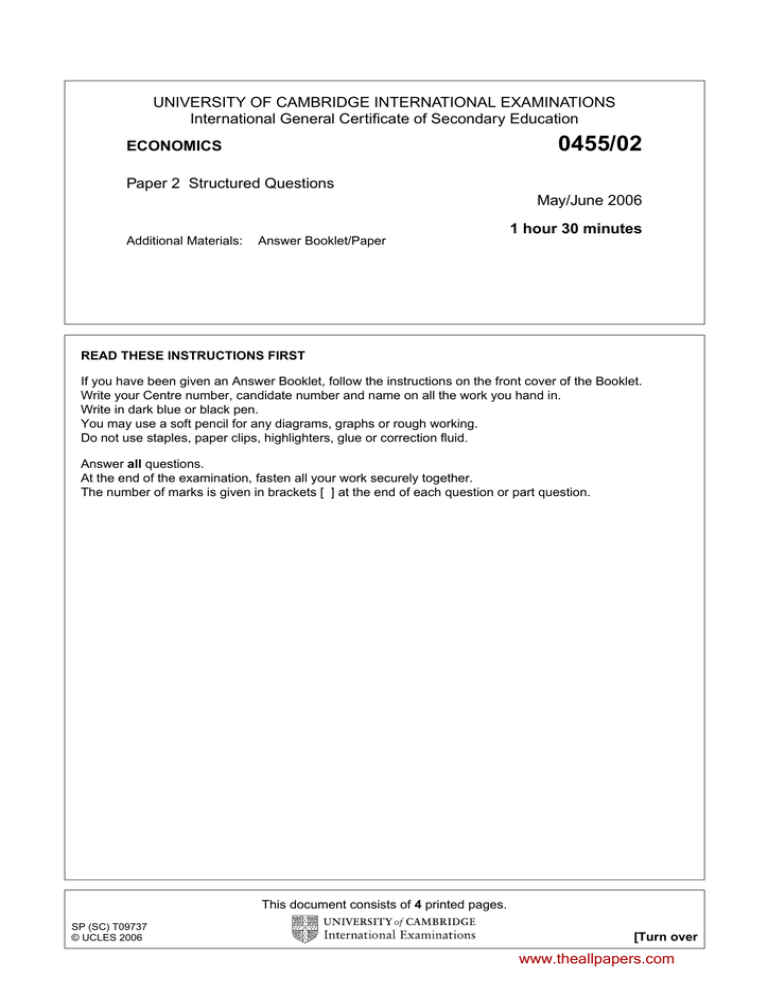
UNIVERSITY OF CAMBRIDGE INTERNATIONAL EXAMINATIONS
International General Certificate of Secondary Education
0455/02
ECONOMICS
Paper 2 Structured Questions
May/June 2006
1 hour 30 minutes
Additional Materials:
Answer Booklet/Paper
READ THESE INSTRUCTIONS FIRST
If you have been given an Answer Booklet, follow the instructions on the front cover of the Booklet.
Write your Centre number, candidate number and name on all the work you hand in.
Write in dark blue or black pen.
You may use a soft pencil for any diagrams, graphs or rough working.
Do not use staples, paper clips, highlighters, glue or correction fluid.
Answer all questions.
At the end of the examination, fasten all your work securely together.
The number of marks is given in brackets [ ] at the end of each question or part question.
This document consists of 4 printed pages.
SP (SC) T09737
© UCLES 2006
[Turn over
www.theallpapers.com
2
Section A
Answer this question.
1
Demand for oil in India
India is the world’s seventh-largest consumer of oil. Demand for oil could more than double in the
next 15 years because of strong industrial growth and increasing numbers of Indians who will be
able to afford to buy cars and motorcycles. As demand grows, so will India’s dependence on
imports. India imports around 70% of its oil.
(a) Explain using a demand and supply diagram what the article says will be the likely change in
the market for oil in India in the next 15 years.
[5]
(b) (i)
Where would the purchase of foreign oil be recorded in India’s balance of payments? [3]
(ii)
Explain two possible disadvantages to the Indian economy of its dependence on
imported oil.
[4]
(c) The article says there will be ‘strong industrial growth’.
(i)
Explain what is meant by strong industrial growth.
[2]
(ii)
Discuss the possible effects of strong industrial growth.
[6]
© UCLES 2006
0455/02/M/J/06
www.theallpapers.com
3
Section B
Answer three questions.
2
3
Sometimes in an industry a firm buys a smaller competitor which uses similar factors of
production. At other times a firm buys another firm which supplies it with the raw materials and
other inputs for its production.
(a) Explain what is meant by the factors of production.
[4]
(b) Discuss the reasons why some firms remain small.
[6]
(a) Explain the terms scarcity and opportunity cost.
[4]
(b) Describe the factors that affect an individual’s choice of occupation and show how the idea of
opportunity cost might be relevant to that choice.
[6]
4
5
Australia’s unemployment rate fell to 5.5% in May 2004, the lowest for 23 years. At the same time
total employment decreased to 9.6 million. Full-time jobs decreased by 42 600 but part-time
employment rose by 1500. The shift from employment in agriculture and manufacturing to
services has continued.
(a) Calculate the change in total employment. (Show your working).
[2]
(b) Explain why the pattern of employment might change.
[8]
(a) Distinguish between the private sector and the public sector of an economy.
[3]
(b) Discuss the disadvantages of allocating resources through the public sector.
[7]
© UCLES 2006
0455/02/M/J/06
www.theallpapers.com
4
Copyright Acknowledgements:
Question 1
Question 4
Reprinted with permission of Far Eastern Economic Review, Copyright © (2004) Dow Jones & Company, Inc. All rights Reserved Worldwide.
Reprinted with permission of Far Eastern Economic Review, Copyright © (2004) Dow Jones & Company, Inc. All rights Reserved Worldwide.
Permission to reproduce items where third-party owned material protected by copyright is included has been sought and cleared where possible. Every
reasonable effort has been made by the publisher (UCLES) to trace copyright holders, but if any items requiring clearance have unwittingly been included, the
publisher will be pleased to make amends at the earliest possible opportunity.
University of Cambridge International Examinations is part of the University of Cambridge Local Examinations Syndicate (UCLES), which is itself a department of
the University of Cambridge.
© UCLES 2006
0455/02/M/J/06
www.theallpapers.com

